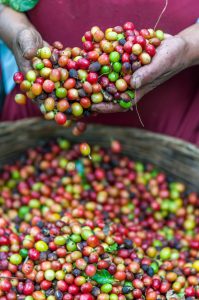
Sumatran coffee is one of the best coffees in the world. The beans that come from this region are highly sought after, and fairly expensive to buy in the local grocery store.
Many of you may even be enjoying a cup of this amazing coffee right now. But, have you ever stopped and wondered how this flavorful coffee makes it to your cup?
Today, we are going to explore a day in the life of a Sumatran coffee picker, and learn the struggles they often face. To learn about Sumatran coffee brands, check out our detailed page.
A Long Day For The Sumatra Coffee Picker
A typical day at the office for many workers starts at 8 a.m., and ends at around 5 p.m. However, if you are a Sumatran coffee picker, then your day will start much earlier than that.
Most coffee pickers, also known as cherry pickers, wake up very early. Many get up at 4 a.m. and cook breakfast. They quickly eat their meal, and as soon as daylight comes, they are off to the fields.
Normally, picking begins around 6 a.m., and it lasts all day. Coffee cherries are picked by hand, and each picker carries around a very large sack.
They work as fast and as hard as they can, filling their sack until it is full. Once the sack becomes too heavy to carry, they are dumped in larger sacks that weigh up to 100 pounds.
Coffee picking is hard on the back and knees. After 10 long hours have passed, the day is finally over with, and the pickers head home for a few hours of rest, before repeating the process. Most cherry pickers work 10 hours a day for 7 days.
Children Can Also Be Cherry Pickers
While some children in the region go to school during the day, others are in the coffee fields with their families. These children often come from poor households.
In order to make ends meet, the mothers and fathers are forced to employ their children as coffee pickers. Otherwise, the family would have to do without necessary things, like food and electricity. But luckily, things are starting to get better for many of these families, thanks to new programs.
Fair Trade Is Making Progress

Most of the areas that Sumatra coffee is grown in is extremely rural. In the past, these coffee farmers took what they could get for their beans, and many barely made enough to get through another growing season.
Now, there are non-profit organizations that are trying to help out. The Fair Trade organization is working directly with farmers to help them improve their lives, by getting more for their beans.
They are helping to bring more money into the communities, so that children can get out of the fields and into the classroom.
Conclusion
Let’s face it, coffee picking is a hard job. It requires long hours and many pickers work 7 days a week. The next time you are enjoying a hot cup of coffee, think about these men and women, and the struggles they go through, just to bring you some of the finest beans in the world.